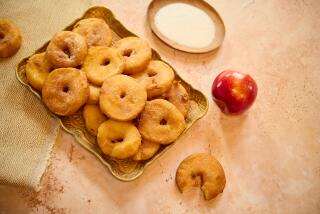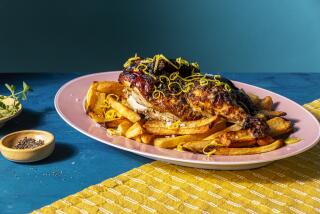Shortcut to Heavenly Baklava
- Share via
Baklava. Say it slowly and loudly--B - A - K - L - A - V - A--and the honey will immediately start dripping from your tongue.
It’s a Greek dish, a messy and sinful concoction of honey and nuts and sugar and pastry, absolutely guaranteed to be frowned on by any nutritionist worth his non-salt.
It’s hard to eat and even harder to prepare, but neither is more trouble than it’s worth.
“It is so terribly rich that I only make it at Christmas and Easter,” says Fran Karnazes, who is known from Orange County to Australia for the excellence of her Greek dishes. “I’m not sure I’d even make it then, except that Greeks are so tradition-bound, and it just wouldn’t be a holiday meal for my family without baklava.”
And while acknowledging that her grandmother, from whom she learned many of her prized dishes, would be horrified at the thought (“Greeks never do anything the easy way”), Karnazes takes one big shortcut with her baklava. “I buy the already-prepared filo dough at the market,” she says.
Filo is the rich, paper-thin pastry that is the main ingredient in baklava. It must be individually brushed with butter and carefully stacked and stuffed before being baked and slathered with syrup. Making filo from scratch would turn an already-long process into an interminable one, Karnazes says.
Karnazes, an English teacher at Serrano Intermediate School in Lake Forest, enjoyed introducing Greek food to a number of neighbors and colleagues during a recent yearlong working sojourn to Australia with her husband, Nick.
Ironically, it was a problem with semantics that temporarily sidetracked her in the kitchen. “One of our favorite pastries is made with spinach,” she says, “and the clerks at the market in the small town where we lived had no idea in the world what I was talking about when I asked for it. It took a while to realize that they don’t call it spinach; they call it ‘silver beet.’ ”
Home for several months now, Karnazes has had little trouble getting back into the swing of things, teaching, keeping house in San Clemente and doing volunteer work for the Greek Orthodox Church in South County. The latter includes whipping up dishes, including baklava, for church affairs.
BAKLAVA
1 cup walnuts, finely chopped
1 cup blanched almonds, ground
1/3 cup sugar
1/4 teaspoon cinnamon
1/8 teaspoon ground cloves
1 1/2 cups sweet (unsalted) butter, melted
1 pound prepared filo dough
Syrup:
2 cups sugar
1 cup honey
1/2 large lemon
1 1/2 cups water
3 whole cloves
In small bowl, mix walnuts, almonds, sugar, cinnamon and cloves. Place 2 sheets of filo in greased baking pan and brush with melted butter. Stack 12 more sheets of filo, buttering each. (Keep covered with damp cloth to prevent drying out.) Sprinkle top layer with one-third of the nut mixture, then pile on six to eight more sheets of filo, buttering each. Repeat process twice more, so that you wind up with three stacks of filo. Brush tops with butter, cut into diamond-shaped pieces and bake at 350 degrees until golden (45 to 55 minutes).
While pastry is baking, make syrup by combining sugar, honey, water and cloves. Squeeze in lemon juice, then slice lemon into five or six pieces and add to other ingredients. Bring to boil in heavy saucepan, stir, lower heat and simmer for 20 minutes. Strain to remove lemon pieces and cloves.
When pastry is removed from oven, pour the syrup over it and let stand overnight in refrigerator before serving.
More to Read
Eat your way across L.A.
Get our weekly Tasting Notes newsletter for reviews, news and more.
You may occasionally receive promotional content from the Los Angeles Times.










